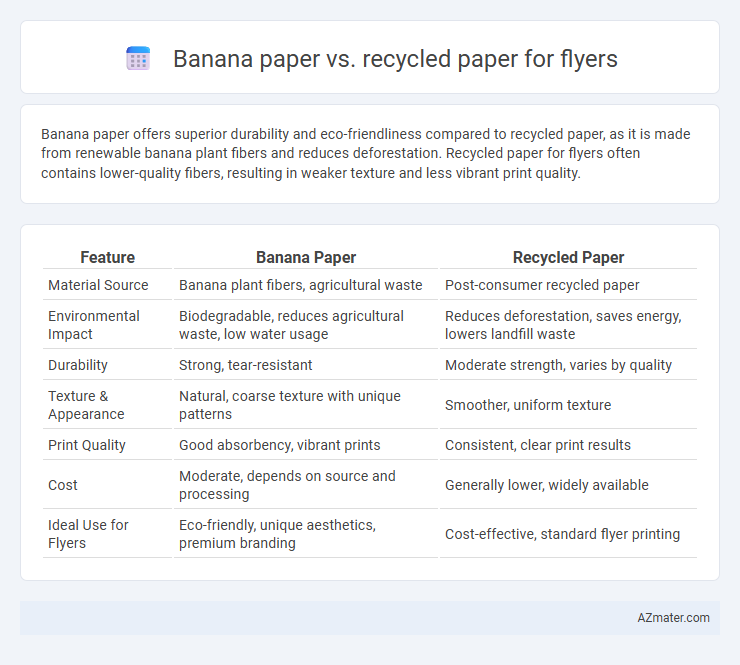Banana paper offers superior durability and eco-friendliness compared to recycled paper, as it is made from renewable banana plant fibers and reduces deforestation. Recycled paper for flyers often contains lower-quality fibers, resulting in weaker texture and less vibrant print quality.
Table of Comparison
| Feature | Banana Paper | Recycled Paper |
|---|---|---|
| Material Source | Banana plant fibers, agricultural waste | Post-consumer recycled paper |
| Environmental Impact | Biodegradable, reduces agricultural waste, low water usage | Reduces deforestation, saves energy, lowers landfill waste |
| Durability | Strong, tear-resistant | Moderate strength, varies by quality |
| Texture & Appearance | Natural, coarse texture with unique patterns | Smoother, uniform texture |
| Print Quality | Good absorbency, vibrant prints | Consistent, clear print results |
| Cost | Moderate, depends on source and processing | Generally lower, widely available |
| Ideal Use for Flyers | Eco-friendly, unique aesthetics, premium branding | Cost-effective, standard flyer printing |
Introduction to Sustainable Paper Choices
Banana paper, made from banana plant fibers, offers a biodegradable and eco-friendly alternative to conventional recycled paper used for flyers, reducing reliance on timber and minimizing waste. Unlike recycled paper, which is repurposed from pre-existing paper products, banana paper supports agricultural byproduct utilization, promoting circular economy principles in paper production. Both choices contribute to sustainability, but banana paper's natural, chemical-free process ensures lower environmental impact and distinct texture ideal for eco-conscious branding.
What is Banana Paper?
Banana paper is an eco-friendly material made from the fibers of banana plants, offering a sustainable alternative to traditional paper. Unlike recycled paper, which is produced from post-consumer waste like old newspapers and office paper, banana paper utilizes agricultural waste, reducing deforestation and chemical processing. Its unique texture and durability make it ideal for eco-conscious flyers seeking both environmental benefits and distinctive aesthetics.
Understanding Recycled Paper
Recycled paper for flyers is primarily made from post-consumer waste, reducing the demand for virgin pulp and conserving natural resources such as trees and water. It offers a sustainable option with varied fiber quality, often requiring less energy and fewer chemicals in production compared to traditional paper. While banana paper incorporates unique, biodegradable fibers from banana plants, recycled paper excels in consistency, cost-effectiveness, and widespread availability for large-scale flyer printing.
Environmental Impact Comparison
Banana paper, made from agricultural waste, offers a lower environmental footprint compared to traditional recycled paper by reducing reliance on wood pulp and minimizing deforestation. The production process of banana paper consumes less water and energy, resulting in fewer greenhouse gas emissions. In contrast, recycled paper still requires energy-intensive processing and often involves chemical treatments that can impact water quality.
Production Processes Explained
Banana paper is produced by extracting fibers from banana plant stems, a sustainable practice that transforms agricultural waste into biodegradable material using minimal chemicals and water. Recycled paper for flyers is made by reprocessing used paper through pulping, de-inking, and refining steps that consume more energy and involve chemical treatments to remove inks and impurities. The banana paper production process reduces environmental impact by utilizing natural fibers and waste, while recycled paper requires extensive mechanical and chemical processing to achieve print-quality standards.
Print Quality: Banana Paper vs Recycled Paper
Banana paper offers a unique texture and natural fibers that enhance print quality with vibrant, eco-friendly results, making images and text appear sharp and distinct on flyers. Recycled paper varies in print quality depending on its fiber content and processing, sometimes showing lower brightness and muted colors, which can affect the vibrancy and clarity of printed designs. Choosing banana paper ensures superior print sharpness and a smoother finish, ideal for high-impact flyers demanding both environmental sustainability and visual appeal.
Cost Analysis for Flyers
Banana paper generally incurs higher production costs compared to recycled paper due to the specialized processing of banana fibers, leading to an increased price per flyer. Recycled paper benefits from established manufacturing infrastructure, resulting in lower material and production expenses that make it a cost-effective choice for bulk flyer printing. Businesses seeking eco-friendly options must weigh the premium cost of banana paper against the affordability and widespread availability of recycled paper for flyer distribution.
Durability and Usability
Banana paper offers superior durability compared to recycled paper due to its long, strong banana fibers that resist tearing and moisture, making it ideal for flyers exposed to various environmental conditions. Its smooth texture provides excellent print clarity, ensuring vibrant colors and sharp text for high-quality flyer presentation. Recycled paper, while eco-friendly and cost-effective, tends to be less durable and can feel rougher, which may result in quicker wear and less professional appearance in flyer applications.
Consumer Perception and Brand Image
Banana paper is perceived as a sustainable and eco-friendly alternative to traditional recycled paper, often associated with innovative and socially responsible brands. Consumers tend to view banana paper flyers as more unique and premium, enhancing brand image through their natural texture and renewable sourcing. Recycled paper, while also environmentally conscious, may be seen as more common and less distinctive, impacting consumer perceptions of a brand's commitment to sustainability and innovation.
Choosing the Best Paper for Eco-Friendly Flyers
Banana paper offers a sustainable alternative to traditional recycled paper by utilizing agricultural waste from banana plants, reducing deforestation and carbon emissions. Recycled paper varies in quality and environmental impact based on the percentage of post-consumer content and processing methods, making it essential to verify certifications like FSC or Green Seal. For eco-friendly flyers, choosing banana paper ensures a unique texture and biodegradability, while recycled paper provides cost-effective options with proven environmental benefits depending on sourcing and manufacturing.

Infographic: Banana paper vs Recycled paper for Flyer
 azmater.com
azmater.com